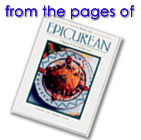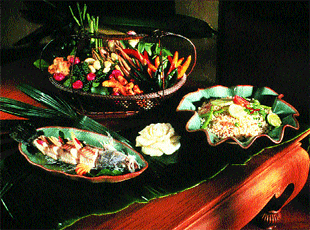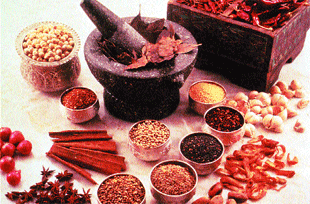
 |
|||||
|
|
|
|
|
|
|
Cooking Thaiby Steven Van Yoder |
|
 We sit classroom style in a small room with teak walls and mahogany desks. Sansern Gajaseni, cooking instructor of the Oriental Hotel's Thai Cooking School, stands at the front of the room writing on a blackboard, explaining the major components of Thai cuisine. "Only in Thai cooking can you find the coexistence of all the major flavor characteristics: sweet, sour, spicy, salty, and bitter," he explains. "In Thai cooking the most important principle is balance; we strive for a variety of flavors, textures, and colors in Thai cooking, but all must be in balance."
We sit classroom style in a small room with teak walls and mahogany desks. Sansern Gajaseni, cooking instructor of the Oriental Hotel's Thai Cooking School, stands at the front of the room writing on a blackboard, explaining the major components of Thai cuisine. "Only in Thai cooking can you find the coexistence of all the major flavor characteristics: sweet, sour, spicy, salty, and bitter," he explains. "In Thai cooking the most important principle is balance; we strive for a variety of flavors, textures, and colors in Thai cooking, but all must be in balance."
A few years ago Thai cuisine was relatively obscure. But over the last decade a proliferation of Thai restaurants in all parts of the world, as well as the fusion of Thai cooking influences into western menus, has helped to make Thai food so popular. It is indeed balance, a melding of extremes into an melange of finely crafted flavors, that has established Thai cuisine as a rising star of international food scene. The Thais are great eaters who view good food as a necessary component to a good life. Thailand's allure, as well as an appreciation of the culture and the people, is inextricably connected to its cuisine. Like the Thais themselves, Thai cooking is irresistible, winning over the majority of those who visit and eat in the kingdom, which explains the burgeoning number of cooking schools in Thailand, each designed to teach the secrets of cooking Thai in students' own kitchens.
Cooking school vacations are becoming popular in all parts of the world. In Thailand they have reached a zenith - there are now more than 100 registered cooking schools in Thailand, forty in Bangkok alone. Perhaps the most prestigious and popular of all Thai cooking schools is The Oriental Hotel's Thai Cooking School, established over a decade ago in a small, restored colonial building across the river from the Oriental Hotel.

The Thai Cooking School is widely considered to be the best in Bangkok. Classes cover the entire range of Thai cuisine: snacks, salads, sauces and curries, noodle dishes, condiments, steamed, fried and grilled foods, and finally, desserts. Students learn to compose a "balanced" and visually attractive Thai meal, complete with self-created fruit and vegetable carvings. Classes are held four days a week, from 9am to noon, available as a four-day package or in one-class segments. Whatever the level of involvement, classes provide a structure for time spent in Bangkok and provide insights into Thai culture. On the first day I was shuttled from the hotel across the Chao Praya River, the River of Kings-a mighty working waterway of barges, multi-colored longtail boats, and riverbanks lined with glittering Buddhist temples that rise against the skyline. After a few minutes I arrive at the cooking school, housed in an atmospheric teakwood building complete with a garden and an outdoor patio. The cooking school has designed its curriculum to be suitable for both experienced and novice cooks, all lessons teach the basic techniques for making fine food that is authentically Thai. Today's lesson is devoted to making soup, but not before devoting time to sort out the cooking styles of Thai cuisine. "Our foods can be divided into three categories," says Sansern to the students, "The first group contains popular foods-phad thai and other "fast food" items often found at streetside stalls and curbside stands. "Next are provincial or country foods," Sansern continues, "These are quick, simple dishes meant to feed a large number of people. They usually do not contain coconut milk, which is expensive, contain cheaper cuts of meat, and are characterized by the unrestrained use of chilies. Basically farm-style cooking with recipes intended to achieve a simple goal, satisfy the largest number of people at the lowest possible cost to the chef." The third type of cooking he calls "city Thai," the more refined haute cuisine that is the dominant cooking style of Bangkok restaurants. Combining the subtle sauces of the French kitchen, the freshness of nouvelle cuisine, and the careful presentation of the Japanese chef, this is unquestionably the most challenging of Thai cooking styles and most closely reflects the Asian idea of yin and yang, a quest for a harmonious balance that as an idea pervades every facet of Thai life. After the lecture we are led into a laboratory-style demonstration room. We sit at large formica tables as the instructor slices and dices, his hands reflected in an overhead mirror at the front of the room. Trays filled with the day's ingredients are passed around, giving students a chance to sniff, taste, and touch the unfamiliar roots, herbs, and spices that comprise the day's recipes, galanga, ginger, powders and pastes, many unfamiliar and all intriguing. Today we will create three Thai soups in three categories: seasoned, herbed, and spicy. The first soup of the day, Tom Som Pla, is a relatively easy to create sweet-and-sour-soup loaded with fresh fish. We watch as red snapper is added to a fragrant mix of coriander, shrimp paste, fish sauce, and tamarind water, which adds a seductive, tangy counterpoint. We move on to the spicier Tom Yaam Talay, a seafood medley of prawns, fish, scallops, squid, and muscles suspended in fresh fish stock spiced with lemongrass, kaffir lime leaves, balsam leaves, and a generous helping of crushed chilies. Finally, we have a hand at Fug Thong Gaeng Buad, four-ingredient "dessert" soup of stewed pumpkin and coconut milk. Sansern, a master of anecdote, gives the dish an interesting contextual spin. "We usually soak the pumpkin in Kaolin, a clay mixture that is used for making pottery. Kaolin is a known narcotic, and is said to provide a hallucinatory effect, and can blacken the teeth of those who overindulge. My grandmother had such a fondness for it that her teeth were permanently darkened." Thailand is in a geographically enviable location to create some of the world's most interesting food. Thailand's tropical environment, which can sizzle brains during peak summer months, provides a year-round blessing to exotic produce. From mangos, papaya, and pineapple, to spices, herbs, and vegetables, Thailand always has a lot to work with in the kitchen. And Thailand's location at the crossroads of India, Indonesia, China, and the rest of Southeast Asia has also contributed to the eclectic and diverse nature of Thai cooking. Thais are masters at the art of culinary assimilation, and much of Thai cooking is the result of borrowing from surrounding nations and other far-flung cultures along its trade routes. China, for instance, has contributed a strong influence to Thai cooking due largely to an influx of ethnic Chinese who helped populate the kingdom over the centuries. The Chinese introduced the emphasis on the balance of the five primary flavors, and the widespread popularity of stir-fry cooking and the use of ingredients such as fish, rice, noodles, soy, and ginger also point to China.
|

India has also influenced Thai food. Some dishes, such as Gaueng Mussaman, an exotically perfumed curry from southern Thailand, may have come directly from Muslim immigrants and Arab traders working the routes of ancient Southeast Asia. Other Indian dishes were learned from Hindu traders and Buddhist monks moving along the Silk Road that connected Tibet to Beijing. Thai curries can be traced to Indian migrants from several hundred years ago who brought cultural influences and a strong faith in Buddhism. One of the most interesting imports to the Thai dinner table came from the West. The chili (prik, in Thai) actually came to the kingdom as a result of Columbus's discovery of pepper while exploring the Caribbean. The chili traveled back to Europe and on to Thailand in the early 16th century with Portuguese merchants visiting the Siamese trading kingdom of Ayuthaya. For the spice loving Siamese, the discovery of something spicier than the then prominent black pepper was a cause for celebration. Today, Thai cooking incorporates more than 40 varieties of chilies that cover a range from larger, mild peppers to the incendiary prik kee noo, translated as "rat shit pepper" on account of their shape. Thai cooking is traditionally taught in the home; and most Thais, from the average citizen to the most seasoned chef, have learned to cook at their mothers' sides in the family kitchen. I came to appreciate that Thai food is not as difficult to create as most European-inspired gourmet fare. The ease with which students can learn to create culinary masterpieces is due largely to the Thais' reliance on artful combinations of ingredients, rather than labor-intensive techniques, to achieve interesting flavor combinations. This simple principle came to light on my second day of class as we created curries, sauces, and condiments, the building blocks of Thai cooking. Like money in the bank, these basic but complex creations are used by Thai cooks to create richly flavored dishes quickly, yet taste like something that took hours to produce. Thai curry pastes are moist, intense blends of chilies and other fresh ingredients, mostly herbal, such as kaffir lime, lemongrass, ginger, cilantro stems and garlic. The ingredients vary little from recipe to recipe, yet altering the proportions can create surprising variations in flavor. "Thai curry paste is the cornerstone of Thai cooking," says Sansern while grinding ingredients into a large mortar. "Thai curries consist of red and green - yellow, brown, and others are the products of other regions or countries." As ingredients are passed around, from piquant, earthy fish sauce to spicy Thai ginger, Sansern tosses out an anecdote or two about things Thai. "Did you know that marijuana is used in Thai cooking as a flavor enhancer?" He asks the room, "Even though it is not a legal substance, many Thai cooks use a pinch or two to sweeten a broth that is added to Beef Noodles. The amount added is entirely up to the chef," he smiles, "and of course, we won't be trying that recipe here today." Once the curry pastes are completed, we head for the kitchen. A gas stove is lit. We stand back to watch ingredients added to a shiny bronze wok. Coconut milk is reduced and thickened. Red curry paste is added and stirred into the milk. Then comes fish sauce, palm sugar, bite sized pieces of beef, and other ingredients that create an aroma simultaneously sweet, sour, salty, and spicy that rises from the wok and fills the room. Since it opened a century and a half ago, the Oriental Hotel has remained the undisputed Grande dame of Bangkok. When Anna Keonowens, the English governess of "The King and I," arrived here in 1862 to teach the children of the King of Siam, the Oriental was already established as a rest house for foreign sailors. Since then the Oriental has thrived, hosting almost every important politician, celebrity, writer, and artist to visit Bangkok. The Oriental has been repeatedly declared the best hotel in the world by scores of travel publications. Bangkok has certainly changed since the Oriental opened over a hundred years ago. Many of its canals have been paved over as streets, and high rise centers of commerce, hardwired into the world economy, tower above the many temples and testaments to Bangkok's past. But despite the arrival of Western fast-food restaurants like Taco Bell and Pizza Hut, Bangkok still remains loyal to its culinary heritage. Bangkok deserves its reputation as one of the world's great culinary destinations. Spread across the city are some 30,000 registered restaurants and countless street stalls that produce some of the most interesting and delicious food in the East. After steeping yourself in Thai cooking in the morning, forays into the city become more meaningful. Whether you head for a shopping spree or a day of sightseeing at the temples, you will have a greater appreciation for Thai food-pungent, exotic, and omnipresent-that surrounds you on the streets of Bangkok. Bangkok can be compared to a big open-air café. The Thais enjoy getting out into the city and being among a crowd. There is even a word for it, pai tio, which means the practice of simply walking around the neighborhoods to see what, and whom, they can see. Pai tio also includes seeing what's cooking and enjoying a bite to eat at any of the local food vendors that occupy every nook and cranny of the capital. Fast food has a whole new meaning in Bangkok, and even the busiest of people can enjoy a well-rounded meal by selecting from the offerings of different food stalls and portable restaurants, common institutions in the Kingdom of Thailand. Because the Thais have liberated food from the western straight jacket of breakfast, lunch and dinner, they snack constantly throughout the day, believing that the time to eat is "when you are hungry." Food stalls are found in long rows at night markets, in small clusters at busy intersections in Bangkok, and dotted here and there among the bustling shopping districts of both small and large cities. Rivaling some of Bangkok's finest restaurants, street stall dining provides a delicious and cheap way to experience a beloved custom unique among the Thais. Stalls with beautifully carved fruit provide a quick bite and relief from the afternoon heat. Charcoal-grilled skewers of chicken, beef, or pork slathered with spicy peanut sauce make a delicious midday snack. Large pots of steaming curry, a bowl of noodle soup, and mango slices with sticky rice and coconut milk, all selected from different vendors, provide a custom-made feast at day's end. Striking is the democratic tone of the street stall dining experience. Meals are priced so cheap that even the poor afford a bowl of noodles. It is not uncommon to find businessmen in suits dining beside the very poor at plastic tables around a vendor's stall. As darkness descends and the working world fills the streets, stalls and pushcarts light up the city with kerosene lamps and fluorescent bulbs powered by a tangle of cords plugged into the city's main power supply, turning Bangkok into a constellation of itinerant chefs displaying their wares. Although street dining is one aspect of Thailand that you might not be able to take home with you, a trip to the kingdom that includes lessons at the Thai Cooking School will help you summon Thailand, wherever you call home.
|
| Thai Recipes | |
Tom Gathi Hoi-shell
Preparation: Pour 2 more cups of coconut milk into the pot and then add scallops. Simmer until cooked. Garnish with coriander leaves and chili shreds. |
Gaeng Kua sapparos Goong Make a chili paste by pounding the dried chilies, garlic, shallots, lemongrass, galanga, and shrimp paste together until they become very pasty and fine. Add the fish meat and continue pounding until mixed well. Bring the coconut milk to a boil and then add paste, keep boiling until slightly reduced and fragrant. Season with tamarind water, fish sauce and pineapple, stir well. Add prawns stir lightly until cooked. Garnish with chili shreds. |
|
|
||||
|
Copyright © 2008 Epicurean.com & Fezziwig Publishing Co. All rights reserved |